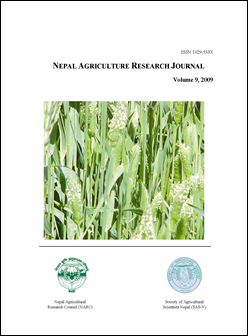An Empirical Analysis of Resource Productivity of Wheat in Eastern Tarai Region of Nepal
DOI:
https://doi.org/10.3126/narj.v9i0.11647Keywords:
Gross margin, Productivity, Resource conservation technologyAbstract
Different types of resource conservation technology (RCT) in wheat cultivation have been recently introduced and use of seed cum fertilizer zero till drill machine is one of them which was used in eastern terai region in wheat season of 2006/2007. A survey was carried out to study the productivity of wheat and compare the production between traditional and RCT method of cultivation. Altogether 31 farmers were interviewed with semi-structured questionnaires. Model used to estimate the productivity for both the methods was significant (p < 0.01) which explained 96 and 97 per cent variation due to independent variables under study in wheat production of traditional and RCT method, respectively. Farmers used 160 kg seed/ha in traditional method while in RCT method it was 122 kg/ha. Similarly, they applied 148 and 137 kg nutrients as a total of nitrogen, phosphorus and potash in traditional and RCT method, respectively. Average production of wheat grain in traditional and RCT method was 2456 and 2714 kg/ha giving average gross margin of Rs 16750.00 and Rs 23301.00/ha, respectively. This revealed 10 per cent reduction in total costs and 29 per cent increase in return by RCT method.
Nepal Agric. Res. J. Vol. 9, 2009, pp. 99-108
Downloads
Downloads
Published
How to Cite
Issue
Section
License
This license allows reusers to copy and distribute the material in any medium or format in unadapted form only, for noncommercial purposes only, and only so long as attribution is given to the creator.




